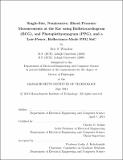Single-site, noninvasive, blood pressure measurements at the ear using ballistocardiogram (BCG), and photoplethysmogram (PPG), and a low-power, reflectance-mode PPG SoC
Author(s)
Winokur, Eric S., 1984-
DownloadFull printable version (27.02Mb)
Other Contributors
Massachusetts Institute of Technology. Department of Electrical Engineering and Computer Science.
Advisor
Charles G. Sodini.
Terms of use
Metadata
Show full item recordAbstract
This work presents a wearable congestive heart failure (CHF) monitor at the ear that uses the ballistocardiogram (BCG), electrocardiogram (ECG), and photoplethysmogram (PPG) to extract mean blood pressure up the Carotid Artery. Being a natural anchoring point, the ear is demonstrated as a viable location for the integrated sensing of physiological signals. The BCG is obtained with an accelerometer, the ECG is taken in a single lead configuration, with one electrode at the mastoid and one on the back of the neck, and the PPG is measured by reflecting light off of the mastoid region above Reid's baseline. When the BCG and PPG are used together, a time delay of the blood pulse wave can be obtained, known as the pulse transit time (PTT), from a single site of measurement. The ear-worn device is wirelessly connected to a computer for real-time data recording. A clinical test involving hemodynamic maneuvers is performed on 15 subjects. The results demonstrate a linear relationship between mean blood pressure and ln(1/PTT ). Using amplitude information from the BCG signal allows for improving the accuracy of the PTT-to-BP algorithm without additional sensors. While the clinical device uses commercial components, a custom integrated circuit for reflectance-mode PPG is designed with the goal of removing static and time-varying interferers while minimizing power consumption and device size. The chip nominally consumes 425[mu]W and only requires LEDs and photodiodes to operate, replacing 7 chips and a MATLAB program compared to the discrete version. The circuit architecture leverages analog and digital techniques to remove up to 100[mu]A of static interferers and attenuate time-varying interferers by 87dB.
Description
Thesis: Ph. D., Massachusetts Institute of Technology, Department of Electrical Engineering and Computer Science, 2014. This electronic version was submitted by the student author. The certified thesis is available in the Institute Archives and Special Collections. 73 Cataloged from student-submitted PDF version of thesis. Includes bibliographical references (pages 149-155).
Date issued
2014Department
Massachusetts Institute of Technology. Department of Electrical Engineering and Computer SciencePublisher
Massachusetts Institute of Technology
Keywords
Electrical Engineering and Computer Science.